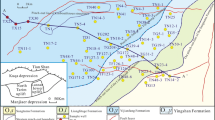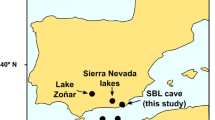Abstract
The area south of the prominent east–west trending Salzach Valley at the northern rim of the Central Alps of Austria has long been known to host anomalously warm springs emerging from a highly deformed calcite marble (Klammkalk). This unit also hosts cavities whose shapes suggest a hydrothermal karst origin and which are lined by calcite spar. We report here petrographic and isotopic evidence suggesting that dissolution by ascending low-temperature thermal waters also played an important role in the origin of a large cave in this region, Entrische Kirche. A paleo cave wall, preserved behind a thick flowstone in the interior of this cave, revealed a brownish bleaching zone which contrasts to the medium grey colour of the unaltered marble beneath. Across this zone the C and O isotope values gradually decrease by 3 and 11‰, respectively. These compositions are very different from those of the speleothem above but are similar to phreatic calcite spar from hydrothermal karst cavities in other outcrops in the area, where the absence of two-phase fluid inclusions suggests a low-temperature (less than ca. 50°C) hydrothermal origin. U/Th dating of the flowstone capping the alteration zone yielded a minimum age of the thermal water invasion in Entrische Kirche of ca. 240 kyr. There is no evidence in Entrische Kirche that these palaeowaters reached the point of calcite precipitation, but it is physically conceivable that higher and as yet unexplored parts of this deep (ca. 900 m) cave contain cavities lined by phreatic cave spar.










Similar content being viewed by others
References
Bakalowicz MJ, Ford DC, Miller TE, Palmer AN, Palmer MV (1987) Thermal genesis of dissolution caves in the Black Hills, South Dakota. Geol Soc Am Bull 99:729–738
Banner JL, Hanson GN (1990) Calculation of simultaneous isotopic and trace element variations during water–rock interaction with applications to carbonate diagenesis. Geochim Cosmochim Acta 54:3123–3137
Becke F (1902) Calcit vom oberen Klammtunnel an der Strecke Schwarzach-St.Veit–Gastein der Tauernbahn. Tschermaks Min Petrogr Mitt 21:460
Beyerle U, Purtschert R, Aeschbach-Hertig W, Imboden DM, Loosli HH, Wieler R, Kipfer R (1998) Climate and groundwater recharge during the Last Glaciation in an ice-covered region. Science 282:731–734
Bottrell SH, Crowley S, Self C (2001) Invasion of a karst aquifer by hydrothermal fluids: evidence from stable isotopic compositions of cave mineralization. Geofluids 1:1103–1121
Braunstingl R (2005) Geologische Karte von Salzburg 1:200000. Geologische Bundesanstalt, Vienna
Budd DA, Hammes U, Ward WB (2000) Cathodoluminescence in calcite cements: new insights on Pb and Zn sensitizing, Mn activation, and Fe quenching at low trace-element concentrations. J Sed Res 70:217–226
Criss RE, Taylor HP (1986) Meteoric-hydrothermal systems. In: Valley JW, Taylor HP, O’Neil JR (eds) Stable isotopes in high temperature geological processes. Rev. Mineral., vol 16. Am. Mineral. Soc., Blacksburg, pp 373–424
Cudrigh SF (2002) Die Wasserwegigkeit des Gasteiner Thermalwassersystems unter Berücksichtigung der Strukturgeologie und im Vergleich zum Thermalsystem Lend. Unpubl. Master thesis, Univ. Salzburg, p 76
Darling WG (2004) Hydrological factors in the interpretation of stable isotopic proxy data present and past: a European perspective. Quat Sci Rev 23:743–770
Dublyansky YV (1995) Speleogenetic history of the Hungarian hydrothermal karst. Environ Geol 25:24–35
Dublyansky YV (2000) Hydrothermal speleogenesis—its settings and peculiar features. In: Klimchouk AB, Ford DC, Palmer AN, Dreybrodt W (eds) Speleogenesis. Evolution of karst aquifers. National Speleol. Soc, Huntsville, pp 292–297
Dublyansky YV (2005) Hydrothermal caves. In: Culver DC, White WB (eds) Encyclopedia of caves. Elsevier, Amsterdam, pp 300–304
Egle S (1991) Geochemische und isotopengeochemische Untersuchungen des Gasteiner Thermalwassers unter besonderer Berücksichtigung der Wechselwirkung mit dem Zentralgneis. Unpubl. MS thesis, Univ. Vienna, p 119
Exner C (1979) Geologie des Salzachtales zwischen Taxenbach und Lend. Jahrb Geol Bundesanstalt 122:1–73
Frank N, Braum M, Hambach U, Mangini A, Wagner G (2000) Warm period growth of travertine during the Last Interglaciation in southern Germany. Quat Res 54:38–48
Friedman I, O’Neil, JR (1977) Compilation of stable isotope fractionation factors of geochemical interest. In: Fleischer M (ed) Data of geochemistry, 6th edn. U. S. Geol. Survey Prof. Paper, 440-KK, pp 1–12
Frimmel HE (1992) Isotopic fronts in hydrothermally mineralized carbonate rocks. Mineral Deposita 27:257–267
Frisia S, Borsato A, Fairchild IJ, McDermott F (2000) Calcite fabrics, growth mechanisms, and environments of formation in speleothems from the Italian Alps and southwestern Ireland. J Sed Res 70:1183–1196
Goldstein RH, Reynolds TJ (1994) Systematics of fluid inclusions in diagenetic minerals. SEPM Short Course 31. SEPM, Tulsa, 199p
Heissel W (1955) Aufnahmsbericht 1954 Kartenblätter 124-Saalfelden und 125-Bischofshofen. Verh Geol Bundesanstalt 1955:36–37
Hoefs J (2004) Stable isotope geochemistry, 5th edn. Springer, Berlin, pp 244
Hölting B, Coldewey WG (2005) Hydrogeologie. Einführung in die Allgemeine und Angewandte Hydrogeologie, 6th edn. Spektrum, Munich, pp 326
Horninger G (1956) Geologische Ergebnisse bei einigen Kraftwerksbauten. Verh Geol Bundesanstalt 1956:114–118
Horninger G (1958) Geologische Ergebnisse bei einigen Kraftwerksbauten. Verh Geol Bundesanstalt 1958:282–286
Horninger G (1959a) Baugeologisches vom Salzach-Kraftwerk Schwarzach. Österr Z Elektrizitätswirtschaft 12:48–50
Horninger G (1959b) Geologische Ergebnisse bei einigen Kraftwerksbauten in Österreich. Verh Geol Bundesanstalt 1959:A112–A115
Humer G (1995) Niederschlagsisotopennetz Österreich Teil 2: Daten. Umweltbundesamt Berichte 33:1–110
Job C, Zőtl J (1969) Zur Frage der Herkunft des gasteiner Thermalwassers. Steir Beitr Hydrogeol 21:51–115
Kendall AC, Broughton PL (1978) Origin of fabrics in speleothems composed of columnar calcite crystals. J Sed Petrol 48:519–538
Klappacher W (1992) Salzburger Höhlenbuch Band 5. Salzburger Mittelgebirge und Zentralalpen. Landesverein für Höhlenkunde in Salzburg, Salzburg, p 625
Langmuir D (1978) Uranium solution-mineral equilibria at low temperatures with applications to sedimentary ore deposits. Geochim Cosmochim Acta 42:547–569
Meyer M (2006) Laminated speleothems as high-resolution archives of alpine paleoclimate. Unpubl. Ph.D. thesis, Univ. Innsbruck, 120p
Müller P (1989) Hydrothermal paleokarst of Hungary. In: Bosak P (Ed) Paleo-Karst: a systematical and regional review. Academia, Prague, pp 155–163
Parkhurst DL, Appelo CAJ (1999) User’s guide to PHREEQC (Version 2)—a computer program for speciation, batch-reaction, one-dimensional transport, and inverse geochemical calculations. U.S. Geological Survey Water-Resources Investigations Report 99–4259, 312p
Peer H, Zimmer W (1980) Geologie der Nordrahmenzone der Hohen Tauern (Gasteiner Ache bis Saukarkopf-Großarltal). Jahrb Geol Bundesanstalt 123:411–466
Plan L, Pavuza R, Seemann R (2006) Das Nasse Schacht bei Mannersdorf am Leithagebirge, NÖ (2911/21) – eine thermal beeinflusste Höhle am Ostrand des Wiener Beckens. Die Höhle 57:30–46
Romanek CS, Grossman EL, Morse JW (1992) Carbon isotopic fractionation in synthetic aragonite and calcite: effects of temperature and precipitation rate. Geochim Cosmochim Acta 56:419–430
Russegger J (1836) Ueber die warmen Quellen des Arlbaches am Ausgange des Groß-Arl-Thales im Salzburgischen. Steiermärkische Zeitschrift N F 3:100–114
Spötl C, Vennemann T (2003) Continuous-flow IRMS analysis of carbonate minerals. Rapid Comm Mass Spectrom 17:1004–1006
Spötl C, Mattey D (2006) Stable isotope microsampling of speleothems: a comparison of drill, micromill and laser ablation techniques. Chem Geol 235:48–58
Stini J (1959) Gastein und der Warmwassereinbruch in den Lender Druckstollen. Geol Bauwesen 23:258–265
Truesdell AH, Hulston JR (1980) Isotopic evidence on environments of geothermal systems. In: Fritz P, Fontes J (eds.) Handbook of environmental isotope geochemistry, vol 1. Elsevier, New York, 179–226
Wang X, Neubauer F (1998) Orogen-parallel strike-slip faults bordering metamorphic core complexes: the Salzach-Enns fault zone in the Eastern Alps, Austria. J Struct Geol 20:799–818
Zimmermann U, Zötl J (1971) Deuterium- und Sauerstoff-18-Gehalt von Gasteiner Thermal- und Kaltwässern. Steirische Beiträge Hydrogeol 23:127–132
Zötl J, Goldbrunner JE (1993) Die Mineral- und Heilwässer Österreichs. Geologische Grundlagen und Spurenelemente. Springer, Vienna, p 324
Acknowledgments
The Amt der Salzburger Landesregierung, Abteilung Naturschutz granted permission to study and sample speleothems for Entrische Kirche. We are grateful to R. Erlmoser and E. Frank for their help in the cave, to J. Reiterer, J. Kaml and J. Ratgeb for kindly providing samples, to W. Gadermayr for discussion and useful hints, to M. Wimmer for preparing the samples for isotopic analysis, to R. Bakker for his help with the fluid-inclusion analyses, to editor W.-C. Dullo and an anonymous referee for comments on an earlier version of the manuscript and to the FWF for financial support (grants Y122-GEO and P18207-N10).
Author information
Authors and Affiliations
Corresponding author
Rights and permissions
About this article
Cite this article
Spötl, C., Dublyansky, Y., Meyer, M. et al. Identifying low-temperature hydrothermal karst and palaeowaters using stable isotopes: a case study from an alpine cave, Entrische Kirche, Austria. Int J Earth Sci (Geol Rundsch) 98, 665–676 (2009). https://doi.org/10.1007/s00531-007-0263-2
Received:
Accepted:
Published:
Issue Date:
DOI: https://doi.org/10.1007/s00531-007-0263-2




